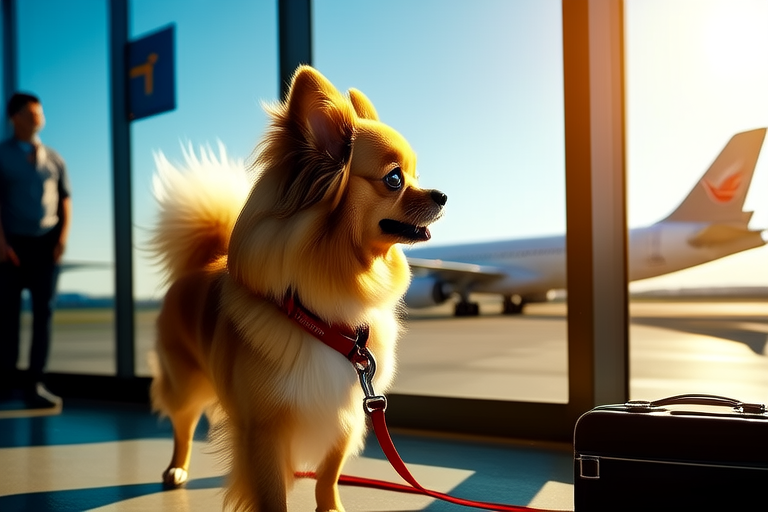
The Evolutionary Journey of the Pomeranian Breed
The Pomeranian, a breed of toy dog renowned for its vibrant coat and lively personality, has a rich history that spans centuries. This journey traces back to the early days when dogs were first domesticated from wolves, evolving through selective breeding practices that have shaped its distinct characteristics. From its origins as a larger, robust breed used for pulling sleds to its current status as a cherished companion, the Pomeranian’s story is one of adaptation, refinement, and cultural significance.
Origins and Early Development
The Pomeranian breed finds its roots in the region of Pomerania, now part of Poland and Germany, where it was known as the Spitz type dog. These early ancestors were much larger than the modern Pomeranian, similar in size to today’s Samoyed or Keeshond. They were primarily used as working dogs, assisting with herding and pulling sleds. The harsh climate of northern Europe required these dogs to be sturdy and resilient, qualities that would later influence the breed’s physical attributes.
The transition from these larger dogs to the smaller Pomeranians began in the 18th century, driven by the preference for diminutive pets among European nobility. Queen Charlotte, wife of King George III of England, was instrumental in this transformation. She imported several of these smaller dogs to England, marking the beginning of a new era for the breed. Her efforts laid the groundwork for further selective breeding aimed at reducing the size of the Pomeranian while preserving its spirited nature.
Selective Breeding and Key Figures
Queen Victoria, a passionate dog lover, took a keen interest in Pomeranians and played a pivotal role in their evolution. She owned a particularly small Pomeranian named Marco, which she brought to Britain during her reign. Victoria’s influence extended beyond mere ownership; she actively promoted the breed through exhibitions and breeding programs. Her advocacy helped establish the Pomeranian as a popular pet among the upper classes.
The breed’s transformation continued under the guidance of dedicated breeders who focused on refining its appearance and temperament. Selective breeding emphasized smaller sizes, more profuse coats, and improved health conditions. By the late 19th century, the Pomeranian had become recognizable as the breed we know today – compact, with a luxurious double coat and an alert demeanor.
Geographical Spread and Cultural Significance
The Pomeranian’s popularity spread rapidly across Europe and North America during the 19th and early 20th centuries. Its presence in royal courts and high society ensured that it became synonymous with elegance and sophistication. In Britain, the breed gained official recognition when it was admitted into the Kennel Club in 1870. Similarly, the American Kennel Club recognized the Pomeranian in 1888.
In addition to its role as a companion animal, the Pomeranian has made appearances in various forms of art and literature. It has been featured in paintings by artists such as Sir Edwin Landseer and has been mentioned in works by notable authors like Jane Austen and Charles Dickens. These references reflect the breed’s widespread appeal and cultural importance.
Temperament, Size, and Coat
The Pomeranian’s temperament is characterized by its intelligence, curiosity, and loyalty. These traits stem from its working dog heritage, where adaptability and close interaction with humans were essential. Over time, selective breeding has enhanced these qualities while also tempering any aggressive tendencies.
Regarding size, the Pomeranian’s diminutive stature is the result of centuries of deliberate breeding. Early breeders sought to create a smaller version of the original Spitz-type dog, leading to a reduction in overall body mass. Today, the average weight of a Pomeranian ranges between three to seven pounds, making it one of the smallest breeds recognized by major kennel clubs.
The breed’s coat is perhaps its most distinctive feature. The Pomeranian boasts a thick, fluffy double coat consisting of a soft undercoat and a longer, coarser outer coat. This luxurious coat provides insulation against cold weather and contributes to the breed’s regal appearance. Various colors and patterns are accepted within the breed standard, adding to its diversity and charm.
Modern-Day Popularity and Challenges
In recent years, the Pomeranian has maintained its position as one of the most beloved toy breeds. Its small size, playful nature, and striking appearance make it an ideal choice for apartment dwellers and families alike. However, the breed does face certain challenges due to its popularity. Some unscrupulous breeders prioritize aesthetics over health, leading to issues such as respiratory problems and joint disorders.
To address these concerns, responsible breeding practices are crucial. Reputable breeders focus on producing healthy puppies with strong genetic backgrounds. They also educate potential owners about proper care and maintenance, ensuring that each Pomeranian receives the love and attention it deserves.
Conclusion
The evolutionary journey of the Pomeranian breed is a testament to the power of selective breeding and human ingenuity. From its origins as a large working dog to its current status as a beloved companion, the Pomeranian has undergone remarkable changes. Through the efforts of influential figures like Queen Victoria and dedicated breeders, this once utilitarian breed has been transformed into a symbol of grace and affection.
Today, the Pomeranian continues to captivate hearts worldwide, embodying the perfect blend of charm and character. Whether lounging on a lap or participating in agility competitions, these pint-sized wonders bring joy and companionship to countless homes. As we look to the future, it is important to uphold ethical breeding standards and ensure that the Pomeranian remains a healthy, happy, and beloved member of the canine family.






